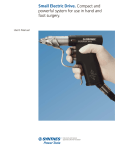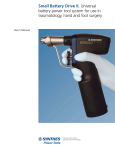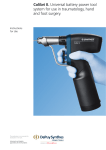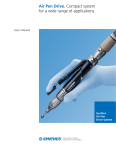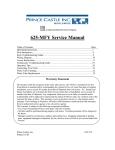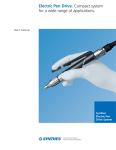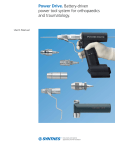Download DePuy Synthes Universal Battery Charger II Specifications
Transcript
Colibri. Universal Battery Power Tool System for Use in Traumatology, Spine and Maxillofacial. Instructions for Use Contents Introduction Using the Colibri Care and Maintenance General Information 2 System Specifications 3 Handpiece 4 Use 6 Attachments 10 General Information 21 Preparation for Cleaning and Disinfection 22 Cleaning and Disinfection 23 Lubrication 25 Inspection and Sterilization 27 Troubleshooting 28 Ordering Information 30 Synthes 1 Introduction General Information Intended Use The Colibri is a battery-driven power tool for use in traumatology, maxillofacial and spinal column surgery. To ensure proper operation of the Colibri, use only Synthes original accessories. Patient safety The Colibri may only be used on patients after the medical personnel have read the instructions. Since it is impossible to fully exclude the possibility of technical problems, always ensure that an alternative system is ready when using the unit on patients. Particular attention should be given to the section “Care and Maintenance“ starting on page 21. Liability of the user The user of the product is liable for proper use of the equipment during surgery. Explanation of symbols used This symbol provides notification of important information. When this symbol is on a device, it refers to important information in the accompanying documents. Starting the system New power tools and their accessories must undergo the entire reprocessing process before being used. Completely remove protective caps and films. Caution – The batteries may never be sterilized. Explosion hazard! – To prevent injury, the power tool must be locked with the safety system when coupling and removing attachments and tools, and before laying it down (see page 4). – Properly operating cutting tools are essential to the success of an operation. For this reason, cutting tools must be checked for wear and/or damage after each use and replaced if necessary. For each operation, we recommend using a new Synthes original cutting tool. Maintenance The life of the equipment can be substantially extended by following the service instructions. For the devices to function properly, Synthes recommends that they be serviced annually by Synthes, or by exclusive Synthes sales outlets. Synthes is not responsible for damage arising from improper use or technical service rendered by unauthorized parties. Additional information on the use and preparation of the products can be obtained from a Synthes representative. 2 Synthes Colibri Instructions for Use This symbol indicates that the corresponding device may not be immersed in liquids. The device is classified as type BF against electrical shock and leakage current. The device is suitable for use on patients according to the standards defined by CSA 601.1, IEC 60601-1 and UL 2601. Ni-Cd Cd This symbol indicates that the battery contains rechargeable NiCd (nickel cadmium) cells. The battery is recyclable (observe the following instructions). Since they contain cadmium, batteries may not be disposed with household garbage. Dispose or recycle the batteries in accordance with local and national regulations. System Specifications The device meets the following standards EN 60601-1 / IEC 601-1 EN 60601-1-2 / DIN EN 60601-1-2, (VDE 0750 part 1–2) EN 55011 / DIN VDE 0875 part 11, class B, group 1 thresholds Medical electrical devices UL 2601-1 Only in conformance with UL 2601-1 and CAN/CSA C22.2 No. 601.1 in reference to electrical shock, fire, mechanical danger. Environmental conditions Operation Transportation and storage Temperature: 10 – 40 °C –20 – 50 °C Relative humidity: 10–100% 10–75% Atmospheric pressure: 500–1060 hPA 500–1060 hPA May not be stored or operated in explosive atmospheres Technical data Continuously adjustable speed: 0–3200 rpm Weight 810 g Operating voltage: 12 VDC 14.4 VDC Battery capacity: 0.5 Ah Battery type: NiCd Cannulation: ⭋ 3.2 mm Empty battery charging time: max. 60 min. Degree of protection against electrical shock: BF Protection against the penetration of water: IP X4 Noise level in operating position: Approx. 65 dB(A) Duty Cycle: Intermittent operation Xmin on Ymin off Drilling and tapping threads: 8 45 Reaming: 8 45 Sawing: 8 45 Kirschner Wire setting: 8 45 Generally, electrical systems can heat up if in constant use. For this reason the handpiece and the attachment should be allowed to cool for at least 45 minutes following 8 minutes of constant use. If this is observed the system will be prevented from overheating and possibly harming the patient or user. The user is responsible for the application and for turning off the system as prescribed. If longer periods of constant use are required, an additional handpiece and/or attachment should be used. Subject to technical modifications. Synthes 3 Using the Colibri Handpiece � Attachment coupling � Trigger for speed regulation � � Trigger for switching to reverse / oscillating drilling � Mode selector switch � � Battery pack (battery casing with inserted battery) � Release buttons for attachment � � Release buttons for battery casing � Knob for the battery casing cover � � � Safety system The Colibri is equipped with a safety system that prevents the machine from being unintentionally started. To lock and unlock the tool, turn the mode selector switch � to the appropriate setting on the front plate of the handpiece: “OFF”, “OSC” or “ON” position. Protective systems The Colibri is equipped with two safety systems: – A thermal overload safety system shuts off the tool if it becomes too hot during use. After it cools, the tool can be used again. – An exhaustive discharge protection ensures that the battery does not completely discharge. This protects the battery and extends its life. � � Speed and rotational direction control Mode selector switch in “ON” position The bottom trigger � gradually controls the forward speed (up to approx. 920 rpm with the AO/ASIF quick coupling). When the bottom and top triggers � are pressed at the same time, the tool immediately switches to reverse. When the bottom trigger is released, the tool immediately stops. Mode selector switch in “OSC” position When the bottom and top triggers � are pressed at the same time, the tool immediately switches to oscillating rotation. When the top trigger is released, the tool returns to normal forward. 4 Synthes Colibri Instructions for Use � � � � � Important notes – To prevent injury, the machine must be locked with the mode selector switch � when coupling and removing attachments and tools, and before laying it down (see page 4). – Never place the Colibri on a magnetic surface since the machine might start unintentionally. – Pay particular attention to all instructions in the individual sections that are identified with “Caution”. – Components that are no longer useful must be disposed of in accordance with local and national regulations. Synthes 5 Using the Colibri Use Before initial use, brand-new tools and accessories should undergo the entire reprocessing process, and the batteries should be charged. Completely remove protective caps and films. Inserting the battery in the battery casing To ensure sterility, the battery is inserted into the battery casing by two people, one of whom is wearing sterile garments: 1. The person with the sterile garments holds the sterile battery casing and opens the cover (Fig. 1). Leave the locking mechanism swung outward. 2. The person wearing the sterile garments places the sterile cover on the battery casing (Fig. 2) and checks if it is seated correctly. The sterile cover ensures that the unsterile battery does not contact the outside of the sterile casing. 3. The person not wearing sterile garments carefully guides the unsterile battery through the sterile cover and presses it completely into the battery casing to ensure a correct seat (Fig. 3 and 4). This person may not contact the outside of the battery casing. The shape of the battery ensures that it is inserted with the correct pole alignment. 4. The person not wearing sterile garments grasps the flanges on the sterile cover and removes it from the battery casing (Fig. 5). 5. The person wearing the sterile garments closes the casing cover from the outside without contacting the battery or the inside of the casing. Fig. 1 Fig. 2 Fig. 3 Fig. 4 Normally, one battery is sufficient for one surgery. For safety, two battery packs (battery casing with the battery) should be kept ready ensuring fast intraoperative changing of batteries under sterile conditions if necessary. Fig. 5 6 Synthes Colibri Instructions for Use Caution – If the unsterile battery contacts the outside of the casing, the casing must be resterilised before being used in the OR. – To close the casing cover, press it firmly to ensure that it is completely closed (Fig. 6 and 7) so that the locking mechanism properly engages. – Sterilize the sterile cover after each use to ensure aseptic conditions when inserting the unsterile battery into the sterile battery casing. Fig. 6 Fig. 7 Inserting the battery pack into the power tool Guide the battery pack (battery casing with inserted battery) from below into the shaft of the handpiece (Fig. 8). The shape of the battery casing prevents the battery from being inserted incorrectly. Check if the battery pack is seated correctly by gently pulling on it. Removing the battery pack from the power tool. Simultaneously press the release buttons for the battery casing with one hand (Fig. 9), and use the other hand to remove the battery pack from the handpiece. Fig. 8 Fig. 9 Synthes 7 Using the Colibri Charging, storing and using batteries Charging – The batteries should always be charged before use. – Only use chargers recommended by Synthes to charge the batteries. Using a charger that does not originate from Synthes can damage the battery. – Charge the batteries within an ambient temperature range of 0 °C to 40 °C. Storage – When the battery is not being used, store it in the appropriate Synthes charger. This will keep it from discharging, and the battery will be fully charged and ready to use. – Before first use or after storing the battery outside of the charger for more than one month, up to five charging/ discharging cycles may be necessary for the battery to be fully charged. – The charging station should always be turned on when a battery is in the charging base. This ensures availability and prevents discharge. Use – Only insert the battery pack directly before using the Colibri. This saves battery energy and prevents having to change it during surgery. – Never open the battery casing during surgery. – Only use batteries for the indicated purpose. – The Colibri 14.4 VDC battery (532.033) may not be used in oscillating mode since this could damage the motor and gears. For this mode, always use the standard 12 VDC battery (532.003). – Only use the 14.4 VDC Colibri battery with the attachments marked with a * on pages 16 and 17. – Do not transport or store the batteries together with materials that conduct electricity and can cause a short. This can damage the battery and generate heat which can cause burns. – Never expose batteries to temperatures above 60 °C. – Do not apply force to the batteries, and do not let them fall. – Never use damaged batteries; they can damage the power tool. – Follow the additional information in the section “Care and Maintenance“ starting on page 21 as well as the Instructions for Use of the Synthes Universal Battery Charger (036.000.725). 8 Synthes Colibri Instructions for Use Using the Colibri with mains current The Colibri can also be operated with mains current. When the Colibri is operated with mains current it is classified as type B against electrical shock and leakage current. When operated with mains current use the corresponding adapter (Art. 05.001.024) and an electrical console belonging to the Electric Pen Drive (Art. 05.001.000, 05.001.001 or 05.001.002). The adapter can be inserted into the Colibri handpiece and removed like a battery pack as described above. Also follow the Electric Pen Drive’s Instructions for Use (036.000.800). “Oscillating drilling” mode To protect soft tissue when drilling and inserting Kirschner wires, the Colibri has an electronically controlled oscillating mode. To preset the oscillating mode, switch the mode selector switch to “OSC“ position. Pressing the bottom trigger by itself causes the tool to rotate clockwise as usual. Simultaneously pressing the top and bottom triggers causes the tool to immediately switch to oscillating mode. The clamped tool oscillates clockwise/anticlockwise. The speed can be changed by means of the bottom trigger. After the top trigger is released, the tool returns to normal clockwise rotation. Caution – Oscillating mode may only be switched on with the following attachments: – AO/ASIF Quick Coupling (532.013) – Jacobs Chuck (532.014, 532.016) – Quick Coupling for Kirschner Wires (532.022) – You can only switch to reverse by turning the mode selector switch to “ON” position. – The maximum cutting speed of an attachment is less in oscillation mode than in normal mode. Synthes 9 Using the Colibri Attachments Mounting the attachments Insert the attachment into the attachment coupling (Fig. 1). If the positioning pins do not lock into place right away, twist the attachment a bit to the right or left until it locks into the correct position. Check if the attachment is seated correctly by gently pulling on it. Removing the attachments Press the attachment release buttons � (see Fig. page 4) simultaneously, and remove the attachment from the coupling. Caution – To prevent injury, the tool must be locked with the safety system (see page 4) during each manipulation. – Only use original attachments and tools from Synthes. Damage that arises from using attachments and tools by other manufacturers is not covered by the warranty. 10 Synthes Colibri Instructions for Use Fig. 1 Quick Coupling for Kirschner Wires (532.022) (Speed: 0–800 rpm) � Kirschner Wires of any length with a diameter of 0.6–3.2 mm can be used with the Quick Coupling for Kirschner Wires. 1. Adjust the Kirschner Wire diameter according to the label on the adjusting sleeve �. Slightly press the adjusting sleeve axially against the tool and rotate the sleeve. 2. Apply a slight amount of pressure to insert the Kirschner Wire from the front or back into the cannulation �. The wire is held automatically. 3. Adjust the working length by pulling on the wire. 4. To affix the wire, pull the tension lever � against the tool with your little finger and ring finger. Only pull the tension lever against the tool as much as necessary. The clamping force can be varied by pulling and releasing the clamping lever. 5. Insert the wire into the bone. Apply the clamping force as long as the wire is advanced. 6. To adjust the grip on the wire, reduce the clamping force and move the tool to the desired length. Reclamp the wire by pulling on the tension lever. � � Synthes 11 Using the Colibri Jacobs Chuck (532.014 and 532.016) The following Jacobs Chucks are available for the Colibri system: Article number Clamping area Speed Spare key 532.014 0–6.0 mm 0–800 rpm 510.190 532.016 0–4.0 mm 0–920 rpm 310.932 Inserting cutting tools Open the jaws of the Jacobs Chuck using the appropriate key or by hand. Insert the shaft of the tool into the open drill chuck, and close it by twisting the chuck. Make sure that the shaft lies central to the three jaws. Tighten the drill chuck with the key. Make sure that the teeth of the key engage correctly in the toothed rim of the chuck. Removing cutting tools Open the Jacobs Chuck with the key and remove the tool. Caution: To ensure a proper seat of the tools, the toothed rims on the drill chuck and key may not be worn. 12 Synthes Colibri Instructions for Use Oscillating Saw Attachment (532.021) Positioning the saw attachment The attachment can be locked in eight different positions (45° steps) when coupled: Lock the machine, shove the sliding sleeve � toward the saw blade coupling, and rotate the attachment into the desired position (Fig. 1). � � Caution – To prevent injury, always grip the saw attachment with the inserted saw blade from the direction of the machine. – When using the Colibri with the Oscillating Saw Attachment, only use the standard 12 VDC battery (532.003). Changing saw blades (Fig. 2). 1. Lock the machine. 2. Pull the locking knob � down and turn it counterclockwise. 3. Lift and remove the saw blade. 4. Use a slight amount of pressure to insert the new saw blade, and turn it to the desired position. The desired positions can be offset from each other at 45º angles. 5. Place your thumb on the saw blade coupling to hold the saw blade, and turn the locking mechanism clockwise until the saw blade is fixed. 6. Unlock the power tool. Fig. 1 Fig. 2 Synthes 13 Using the Colibri Positioning the saw blades The saw blades can be adjusted in the desired position vertically and horizontally at an angle of 45º (See the prior sections: “Positioning the saw attachment“ and “Exchanging saw blades“). Using the oscillating saw attachment The saw blade must already be oscillating when the saw is applied to the bone. Do not apply strong pressure to the saw blade; this will delay the cutting process, and the saw teeth will catch in the bone. The best sawing performance is achieved by moving the power tool slightly back and forth in the plane of the saw blade so that the blade oscillates beyond the bone on both sides. Very precise cuts can be made when the saw blade is guided steadily. Imprecise cuts arise due to used blades, excess pressure, or jamming the saw blade. Fig. 3 Instructions for handling saw blades Synthes recommends using a new blade for each operation to ensure that the saw blade is optimally sharpened and clean. The following risks are associated with used blades: – Necrosis caused by excessive heat build-up – Infection caused by residue – Extended cutting time from poor sawing performance 14 Synthes Colibri Instructions for Use Oscillating Saw Attachment II (Crescentic Technique) (532.023) The Oscillating Saw Attachment II is essentially designed for use with semicircular saw blades (for example 03.000.313S) guided by a 1.6 mm Kirschner Wire. It can also be used with saw blades with a shaft extension (for example 03.000.340S) for reaching difficult-to-access sites (such as intraoral). Inserting saw blades Pull the saw blade coupling toward the handpiece, and insert the saw blade while rotating it slightly until it locks into the saw attachment coupling. Release the saw blade coupling, and check if the saw blade is correctly fixed by gently pulling on the saw blade. Removing the saw blades Pull the saw blade coupling toward the handpiece to release the saw blade. Caution: – The saw attachments may only be used with the hand piece in the “ON” mode. Never use the attachments in oscillation mode (“OSC“). – The appropriate surgical technique (036.000.907) should be observed to ensure safe and successful application of the Crescentic Technique. Synthes 15 Using the Colibri Mini Quick Coupling (532.011) J-Latch Coupling (532.012) (Speed: 0–3200 rpm) The Mini Quick Coupling and the J-Latch Coupling are compatible with all protection sleeves for the MicroDrive plus (512.101) and Mini Air Drill (512.100) systems by Synthes. AO/ASIF Quick Coupling (532.013) (Speed: 0–920 rpm) For tools with an AO/ASIF coupling shaft Quick Coupling for DHS/DCS® Triple Reamers (532.015)* (Speed: 0–320 rpm) For tools with an AO/ASIF Coupling shaft For DHS/DCS Triple Reamers; can also be used to open the medullary cavity with a range of Synthes nail systems. * For these attachments, the 14.4 VDC Colibri battery (532.033) with the corresponding battery casing (532.032) – called “Power Pack” – can be used. 16 Synthes Colibri Instructions for Use Quick Couplings for Medullary Reaming AO/ASIF Quick Coupling (532.017)* Hudson Quick Coupling (532.018)* Trinkle Quick Coupling (532.019)* Trinkle Quick Coupling, modified (532.020)* (Speed: 0–320 rpm) The Quick Couplings for Medullary Reaming enable flexible shafts with the appropriate coupling geometry to be coupled. Reverse, which can damage the flexible shafts, is prevented by a special mechanical system. * For these attachments, the 14.4 VDC Colibri battery (532.033) with the corresponding battery casing (532.032) – called “Power Pack” – can be used. The “Power Pack” can also be used for the Oscillating Saw Attachment II (532.023). For operating with all other attachments, use the standard battery (532.003) and the battery casing (532.002). Inserting cutting tools into the coupling Maneuver the unlocking ring on the attachment forward or backward, and insert the tool (such as a drill bit) while rotating it slightly until it locks into place. Release the ring. (With the AO/ASIF Quick Coupling (532.013), the tools can be inserted without sliding the unlocking ring). Check if the tool is seated correctly in the coupling by gently pulling on it. Removing cutting tools Push the unlocking ring on the attachment forward or backward, and remove the tool. Caution – Do not use Quick Couplings for Medullary Reaming for acetabular reaming. They may only be used for medullary reaming. – Check the cutting tool for wear and/or damage after each use, and replace if necessary. Synthes 17 Using the Colibri Radiolucent Drive (511.300) (Speed: 0–920 rpm) The Radiolucent Drive can be used with the Compact Air Drive II in combination with the AO/ASIF Quick Coupling (511.750). Coupling the Radiolucent Drive to the power tool Connect the AO/ASIF Quick Coupling to the Colibri and the adapter to the Quick Coupling. Position the Radiolucent Drive as far as it will go over the Quick Coupling and the adapter, and rotate it into the desired working position. Support the drive with your free hand. Removing: Follow the same procedure in reverse. Inserting the drill bit Pull the ring on the attachment forward, and position the drill bit into the coupling as far as it can go while rotating it slightly. Engage the ring on the attachment back to fix the drill. Check if the drill bit is seated correctly by gently pulling on it. Removing: Follow the same procedure in reverse. 18 Synthes Colibri Instructions for Use (532.013) (532.031) (511.300) Using the Radiolucent Drive: Before positioning the Radiolucent Drive, align the image intensifier until the distal locking hole of the medullary nail is round and easily visible. After the incision, position the Radiolucent Drive and center the drill bit tip over the locking hole. On the monitor of the image intensifier, you can see both the drill bit and the target rings of the drive. Swing the drive up and center it precisely so that the drill bit appears as a round point and the locking hole is visible around it. The target rings also assist centering. The locking hole can now be drilled directly. Caution – Grip the coupled Radiolucent Drive tightly when the power tool is held downward. – Only special 3-flute spiral drill bits can be used. Your Synthes representative will be glad to provide you with additional information on which drill bits can be used. – Handle the Radiolucent Drive with great care. Do not allow contact between the drill bit and the medullary nail. – Depending on the setting of the image intensifier, a zone may appear in the rear of the Radiolucent Drive that is not radiolucent. However, this does not inhibit aiming and working with the device. – To protect the gears, the Radiolucent Drive is equipped with a slip clutch that disengages in case of an overload and emits an audible rattling. – The following procedures can cause an overload: – Correcting the drilling angle when the cutting edges of the drill bit are completely in the bone. – Running into the nail with the drill bit. – Drilling can continue after making the following corrections: – Correcting the drilling angle: Remove the drill bit until the flutes are visible, and restart drilling. – Hitting a nail: Remove the drill bit until the flutes are visible, and re-aim the drill bit or exchange the drill bit if necessary. Synthes 19 Using the Colibri Torque Limiter 1.5 Nm (511.773), Torque Limiter 0.8 Nm (511.776), and Torque Limiter 0.4 Nm (511.777) Coupling the Torque Limiter to the power tool Torque Limiters are connected to the Colibri using the AO/ASIF Quick Coupling (532.013). Mounting and removing a screwdriver shaft: Insert the screwdriver shaft while rotating it slightly until it locks into place. To remove it, pull back the unlocking ring, and pull out the screwdriver shaft. Using the Torque Limiter: Pick up a screw from the corresponding locked plating system with the screwdriver shaft, and insert it in the desired plate hole. To insert the screw, start the power tool slowly, increase the speed and then reduce it again before the screw is fully tightened. The torque is automatically limited to 1.5, 0.8, or or 0.4 Nm. When this limit is reached, you will hear a distinct clicking. Stop the tool immediately, and pull the tool away from the screw. Follow the surgical technique of the respective locked plating system. Caution: The Torque Limiter must be annually serviced and recalibrated by Synthes. Note the information on the test certificate in the packaging. The user is responsible for following the calibration schedule. 20 Synthes Colibri Instructions for Use Care and Maintenance General Information Regular care and maintenance according to the following instructions (fulfilling DIN EN ISO 17664) can substantially increase the reliability and life of the system components. Synthes recommends annual servicing and inspection by the original manufacturer or its exclusive sales outlets. The manufacturer assumes no warranty for damages arising from improper use or unauthorized servicing. If not stated otherwise, the following reprocessing steps apply to the entire Synthes Colibri product line. Detergents used on the products will contact the following materials: stainless steel, aluminum, plastic, and rubber seals. Caution – Cannulations, unlocking sleeves and other narrow sites require special attention during cleaning. – Detergents with a pH above 11.0 can reduce the life of the products. – Lubricating regularly with Synthes special oil, especially when mechanical cleaning is performed, will reduce wear and can substantially extend the life of the product. Restriction regarding reprocessing Frequent reprocessing does not have a great effect on the life of the unit and attachments. The expiration of the product’s service life is normally determined by wear and damage from use and can be determined in a timely manner through annual servicing. Synthes always recommends that cutting tools such as saw blades be only used once to ensure optimum patient treatment. Synthes 21 Care and Maintenance Preparation for Cleaning and Disinfection In the operating room Remove surface soiling with a disposable cloth or paper towel. Storage and transport No special requirements. Reprocess an instrument directly after it is used so that blood does not dry on it. Preparation for cleaning – Reprocessing must be carried out immediately after each use. – Before disinfection and cleaning, all attachments and instruments must be removed from the machine. – Remove the battery pack from the power tool and take the battery out of the housing. Immediately charge the batteries after each use in the Synthes battery charger. Wipe off the batteries now and then with a cloth. – The machine and attachments should not be immersed or cleaned in liquids. – Do not use pointed objects for cleaning. 22 Synthes Colibri Instructions for Use Cleaning and Disinfection Manual cleaning and disinfection 1. Wipe or spray the outside of the unit, battery housing and accessories with disinfectant and let the disinfectant work according to the instructions of the disinfectant’s manufacturer. 2. Remove all residues from the disinfected machine and accessories under running water using a soft brush or cloth. 3. Clean cannulations of the power tool and attachments with the provided cleaning brush. Fig. 1 shows an example of how to clean the cannulation in the power tool. 4. Coupling sleeves, sliding sleeves and similar difficult-toaccess locations require special attention. 5. Rinse the unit and accessories with clear water and then dry with an absorbent cloth. 6. Open the saw blade coupling with the locking mechanism to clean the Oscillating Saw Attachment (532.021). Clean all sides of the positioning pins and fixing cap with a soft brush under running water. Press the fixing cap downward with your thumb so that the O-ring below on the locking mechanism is made visible. Make sure that the O-ring is not totally exposed (See Fig. 2) since it could otherwise be ejected and damaged while cleaning. Also clean the locking knob and its shaft up to the O-ring with a soft brush under running water. 7. Dry the power tool and accessories with an absorbent cloth. Fig. 1 Fig. 2 Caution – The battery contacts must not come into contact with water or solvents (short-circuit hazard). – The batteries may not be disinfected. – Reprocessing must be carried out immediately after each use. – Let the disinfectant act for the period indicated in the respective instructions for use. – Never immerse the unit and attachments in liquids. – Do not use pointed objects for cleaning. – Make sure that the triggers, release buttons and lever of the safety system is free of all residues and can be easily actuated. Synthes 23 Care and Maintenance Automated cleaning and disinfection (Validated with Miele G 7735 CD, program: Vario TD; detergents: Deconex 23 Neutrazym) 1. Manually clean critical sites such as cannulations, unlocking sleeves and other difficult-to-access locations. 2. Place all articles in the washing tray in a way that an effective washing/disinfection can be performed. Ensure that the water can flow off any surface. Place the handpiece in such a way that the attachment end (the tool coupling end) points diagonally downward. We recommend using the Holder for Washing Machine Baskets (No. 68.000.100) as shown in Fig. 1 on the right 3. Prewash with cold water 4. Wash with detergent according to the instructions of the detergent manufacturer 5. Rinse with tap water and then with cold demineralized water 6. Thermally disinfect with demineralized water at 92° 7. Dry with hot air at 90°. 8. Upon removing the devices, inspect the cannulations, coupling sleeves, etc. for visible soiling. If necessary, repeat the cycle or clean manually. Caution – For automated cleaning, also consult the brochure “Synthes Power Tools – Machine Washing Recommendations” (036.000.101). – Power tools (especially seals and bearings) are exposed to greater stress in machine washing than when they are cleaned manually. For this reason, power tools must be lubricated (see page 25) and regularly sent to be serviced (at least once per year) when they are machine washed. – Other cleaning and disinfecting methods are possible. Have an expert check the effectiveness under local conditions. – Other detergents and disinfectants are possible. Clarify the material compatibility and effectiveness beforehand with the detergent or disinfectant manufacturer. 24 Synthes Colibri Instructions for Use Fig. 1 Lubrication The power tool and attachments should be regularly lubricated to ensure a long service life. It is recommended to oil the accessible moving parts of the unit, battery casing and attachments with 2–3 drops of Synthes special oil (519.970) and distribute the oil by moving the components. Wipe off excess oil with a cloth. Fig. 1 2 2 2 The poster „Care and Maintenance“ (Art. 038.000.017), has clear pictures showing which items need lubrication. To order this, please contact your local Synthes representative. 2 2 Lubricating the power tool (Fig. 1 and 2) – Lubricate the trigger shafts and then press the triggers several times. – Lubricate the attachment release buttons and then press the buttons several times. – Lubricate the battery casing release buttons from both the outside and inside (see Fig. 2) and then press the buttons several times. – Lubricate the mode selector switch and then move it several times. – Lubricate the attachment coupling. Fig. 2 2 Fig. 3 Lubricating the battery casing (Fig. 3) – Place oil on the seal of the cover, and then evenly distribute the oil on the seal – Lubricate the lock, hinge and knob, then actuate it several times. 2 2 2 Synthes 25 Care and Maintenance Lubricating the attachments Jacobs Chuck (532.014/532.016) Lubricating jaws and toothed rim. Open and close the drill chuck several times. Quick Coupling for Kirschner Wires (532.022) Lubricating tension lever and clamping mechanism. Hold the Quick Coupling up and add two drops of oil into the attachement hole and on the holder of the lever (Fig. 2). Move the tension lever several times. Mini Quick Coupling (532.011), J-Latch Coupling (532.012), AO/ASIF Quick Coupling (532.013), Quick Coupling for DHS/DCS® Triple Reamers (532.015), Quick Coupling for Medullary Reaming (532.017/532.018/532.019/532.020) Lubricating unlocking ring. Move back and forth several times. Fig. 1 Oscillating Saw Attachment (532.021) Lubricating locking mechanism and saw blade coupling. Open and close the locking mechanism several times. Oscillating Saw Attachment II (532.023) Lubricating unlocking sleeve, tool holder and attachment coupling. Move back and forth several times. Caution – To ensure a long service life and reduce repairs, the power tool and all attachments must be lubricated after each use. Exception: The Radiolucent Drive (511.300) may not be lubricated. – The power tool and accessories may only be lubricated with Synthes special oil (519.970). The composition of the vapor-permeable and biocompatible oil is optimized for the specific requirements of the power tool. Lubricants with other compositions can cause the power tool to jam and be toxic. – Only lubricate the power tool and attachments when clean. 26 Synthes Colibri Instructions for Use Fig. 2 Inspection and Sterilization Inspection and function test – Visually inspect for damage and wear. – Check the handpiece controls for smooth operation and function. – Check the coupling and unlocking sleeves of the handpiece and attachments for smooth operation, and check for function together with instruments such as cutting tools. Packaging – We recommend the Synthes Vario Case (689.040) or sterilizing trays in combination with double-layer sterile paper. – Sterile containers can also be used. Please follow the manufacturer’s instructions. Sterilization (Validated with AD Linden 3/3/6 DECE) For sterilization, we recommend a fractionated prevacuum method with the following parameters: – Temperature: 134 °C – Plateau time: 5 minutes – Programs with a longer plateau time are also possible. – After sterilization, the handpiece may only be used when it has cooled to room temperature. Cooling may not be accelerated. When the machine has cooled and the battery pack is attached, the power tool is ready to use. Caution – The following maximum values may not be exceeded: 143 °C over a maximum of 22 minutes. Higher values can damage the sterilized products. – The batteries may not be sterilized: Explosion hazard! – The battery housing must be sterilized when open. – The machine and battery housing may not be joined when they are sterilized. – Hot air sterilization, ethylene oxide and formaldehyde sterilization are not suitable for reasons of material incompatibility. – Other sterilization methods are possible. Have an expert check the effectiveness of all sterilization methods under local conditions. Storage No special requirements (environmental conditions: see page 3). Follow the instructions of the sterile paper and sterile container manufacturers. Contact Manufacturer Please consult a local Synthes representative if you need any additional information. Synthes 27 Troubleshooting Problem Possible causes Remedy Tool does not start. Battery is dead. Charge the battery or replace it with a charged battery. The tool was not cooled off after sterilization. Let the tool cool to room temperature. Safety system is activated. Turn the mode selector switch to ”ON“ or ”OSC“. No contact between the tool and battery pack. Reinsert the battery pack or replace it. Tool does not have enough power. Battery is dead. Charge the battery or replace it with a charged battery. The machine stops suddenly. The tool is overheated (overload protection is activated). Let the tool cool to room temperature. Battery is dead. Charge the battery or replace it with a charged battery. Attachments cannot be coupled to the tool. The tool coupling is plugged from deposits Lock the machine. Remove particles with blunt tweezers. Tool is difficult to couple or cannot be coupled. The attachment or tool is deformed from wear. Replace the attachment or tool, or send it to a Synthes service center. The Kirschner wire is inserted in the drill and cannot be moved forward. The Kirschner wire was inserted from the rear. Lock the machine. Remove the attachment, hold the drive shaft opening down, and shake out the Kirschner wire. Bone and tool heat up during surgery. The cutting tool is blunt. Replace the tool. Oscillating saw attachment vibrates too much. The saw blade locking mechanism is not tight. Tighten the locking knob of the saw blade coupling. The mode selector switch is set to “OSC”. Turn the selector switch to “ON”. 28 Synthes Colibri Instructions for Use Problem Possible causes Remedy It is difficult to close the battery casing. The battery casing seal has become brittle from repeated cleaning. Lubricate the seal as described on page 25. The battery casing knob is difficult to turn. The locking mechanism needs to be lubricated. Lubricate the locking mechanism as described on page 25. The knob mechanism needs to be lubricated. Lubricate the knob as described on page 25. The triggers are difficult to move. The trigger shafts need to be lubricated. Lubricate the trigger shafts as described on page 25. It is difficult to couple the battery casing to the machine. The battery casing release buttons need to be lubricated. Lubricate the release buttons as described on page 25. If the recommended solutions do not work, send the power tool to your local Synthes service center. For further technical questions or information on our services, please contact your Synthes representative. Synthes 29 Ordering Information Drive unit 532.001 Saw blades (for 532.021) Colibri Art. No. non-sterile Art. No sterile Usable Width length (mm) (mm) Cut thickness (mm) Charger, Battery and Accessories for Battery 532.041 532.041S 15 mm 6 mm 0.4 mm 532.002 Battery Casing for Nos. 532.001 and 532.010, Standard 532.042 532.042S 15 mm 10 mm 0.4 mm 532.003 Battery for Colibri, 12 V, Standard 532.043 532.043S 15 mm 16 mm 0.4 mm 532.032 Battery Casing for 14.4 V battery, for Colibri 532.044 532.044S 18 mm 4 mm 0.4 mm 532.033 Battery for Colibri, 14.4 V 532.045 532.045S 22 mm 8 mm 0.4 mm 532.004 Sterile Cover for Colibri 532.046 532.046S 22 mm 12 mm 0.4 mm 530.600 Universal Battery Charger for Synthes® Batteries, 2 Charging Bays 532.047 532.047S 31 mm 6 mm 0.4 mm 530.601 Universal Battery Charger for Synthes® Batteries, 4 Charging Bays 532.048 532.048S 31 mm 10 mm 0.4 mm 532.061 532.061S 27 mm 6 mm 0.6 mm Attachments 532.062 532.062S 27 mm 10 mm 0.6 mm 532.011 Mini Quick Coupling, for Colibri 532.063 532.063S 27 mm 14 mm 0.6 mm 532.012 J-Latch Coupling for Colibri 532.064 532.064S 50 mm 10 mm 0.6 mm 532.013 AO/ASIF Quick Coupling for Colibri 532.065 532.065S 50 mm 14 mm 0.6 mm 532.014 Jacobs Chuck with Key, for Colibri, clamping range up to ⭋ 6.0 mm 532.066 532.066S 50 mm 20 mm 0.6 mm 532.016 Jacobs Chuck with Key, for Colibri, clamping range up to ⭋ 4.0 mm 532.067 532.067S 50 mm 27 mm 0.6 mm 532.015 Quick Coupling for DHS/DCS triple reamers, for Colibri * 532.017 AO/ASIF Quick Coupling for Medullary Reaming, for Colibri* Saw blades (for 532.023) 532.018 HUDSON Quick Coupling for Medullary Reaming, for Colibri* 532.019 Trinkle Quick Coupling for Medullary Reaming, for Colibri* Art. No sterile Usable Blade width Cut thickness Diameter length (mm) (mm) (mm) (mm) 532.020 Trinkle Quick Coupling, modified, for Medullary Reaming, for Colibri* 03.000.311S 26.5 13.3 0.60 18 532.021 Oscillating Saw Attachment, for Colibri 03.000.312S 25 16.3 0.60 22 532.022 Quick Coupling for Kirschner Wires ⭋ 0.6 to 3.2 mm, for Colibri 03.000.313S 30 17.9 0.60 18 532.023 Oscillating Saw Attachment II (Crescentic Technique), for Colibri 03.000.316S 30 21.9 0.60 22 532.031 Adapter for Radiolucent Drive, for Colibri Art. No sterile Usable length(mm) Blade width Cut thickness Shaft length (mm) (mm) (mm) 511.300 Radiolucent Drive 03.000.340S 7 12.0 0.38 511.773 Torque Limiter, 1.5 Nm, for AO/ASIF Quick Coupling 03.000.341S 12 11.5 0.38 70 511.776 Torque Limiter, 0.8 Nm, for AO/ASIF Quick Coupling 03.000.342S 12 9.5 0.38 70 511.777 Torque Limiter, 0.4 Nm, for AO/ASIF Quick Coupling 03.000.343S 12 4.5 0.38 70 70 Power supply, power adapter and accessories 05.001.002 Basic Console, for Electric Pen Drive 05.001.024 Adapter for Colibri, for Electric Pen Drive 05.001.027 Seal Nipple for Cable, for Electric Pen Drive Accessories 689.040 Vario Case™, size 1/1, for Colibri, without lid, without Contents 689.042 Vario Case, size 1/2, for Colibri Power Pack, without lid, without contents 689.507 Lid (stainless steel), size 1/1, for Vario Case 689.537 Lid (stainless steel), size 1/2, for Vario Case 519.400 Cleaning Brush 519.970 Oil Dispenser with Synthes Special Oil 532.024 Cleaning Brush for Oscillating Saw Attachment II (532.023) 30 Synthes Colibri Instructions for Use Cutting tools Detailed ordering information on the cuttings tools for the Colibri machine system with original-size pictures can be found in the brochure on saw blades (Art. No. 036.000.172). * It is recommendable to use the more powerful battery for these attachments (532.033) 036.000.173 Presented by: SE_066005 AA 40050022 © Synthes 2006 Subject to modifications




































